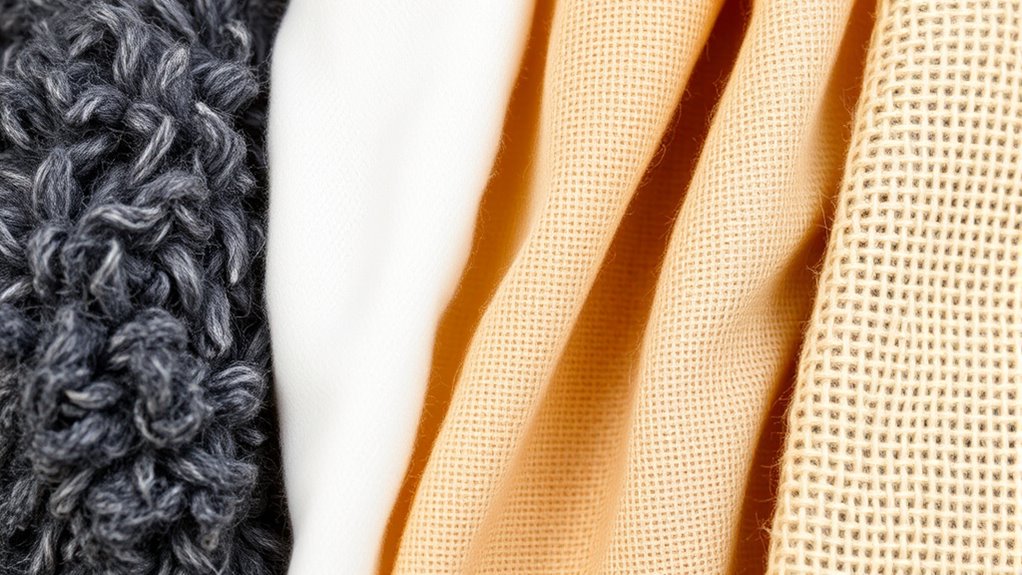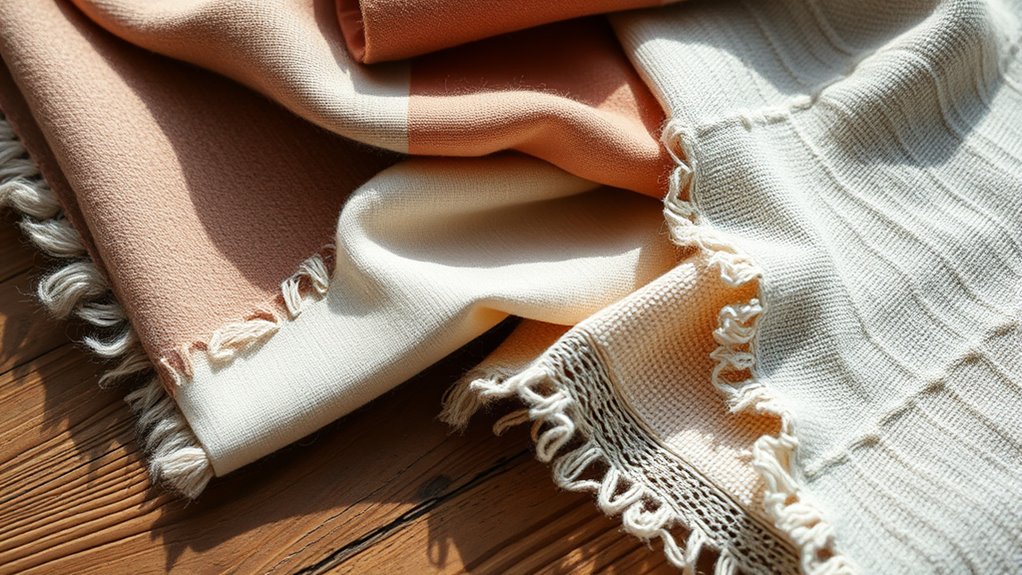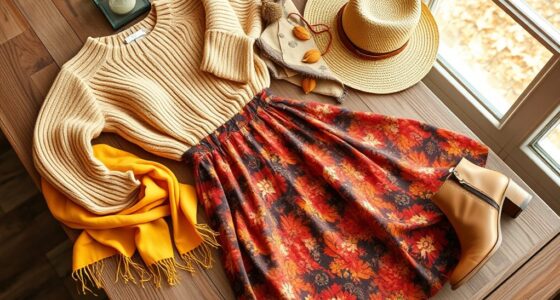Understanding fabrics like wool, cotton, linen, and their blends helps you choose eco-friendly, durable clothing. Wool is natural, insulating, and long-lasting if cared for properly, while cotton offers softness and breathability, especially when organic. Linen, made from flax, is sustainable and moisture-wicking, perfect for warm climates. Blends combine fibers for durability and style, with proper care extending their life. Keep exploring to learn tips on caring for these fabrics and making eco-conscious choices.
Key Takeaways
- Wool is a durable, insulating fiber from sheep, naturally elastic, and best cared for through gentle washing and air drying.
- Cotton is soft, breathable, and versatile, with organic options that are more sustainable and environmentally friendly.
- Linen, made from flax, offers high breathability and moisture-wicking, ideal for warm climates and requires gentle care.
- Blends combine fibers like wool, cotton, linen, and polyester to enhance durability, appearance, and eco-friendliness.
- Proper fabric care—gentle washing, cold water, air drying—extends lifespan and supports sustainable clothing choices.

Have you ever wondered what makes different fabrics feel and behave the way they do? Understanding the basics of fabrics like wool, cotton, linen, and their blends can help you make smarter choices for your wardrobe and the environment. When exploring sustainable fabric options, it’s important to consider how these materials are produced and how they can be cared for to extend their lifespan. Knowing fabric care tips is essential to keep your clothing looking and feeling great longer, especially when choosing eco-friendly options.
Understanding fabric basics helps you choose sustainable, eco-friendly clothing that lasts longer with proper care.
Wool is a natural fiber harvested from sheep and is well-known for its insulation properties and durability. It’s a renewable resource, especially when sourced from sustainable farms that prioritize animal welfare and environmentally friendly practices. Wool’s natural elasticity makes it resistant to wrinkles, and it can regulate temperature, keeping you warm in winter and cool in summer. When caring for wool, gentle fabric care tips are crucial—you should hand wash or use a delicate cycle with cold water, and avoid harsh detergents that can damage the fibers. Air drying is best to prevent shrinkage or felting, which can happen if exposed to high heat. Wool’s sustainability makes it a popular choice for eco-conscious consumers looking to reduce their carbon footprint.
Cotton is another natural fiber, widely appreciated for its softness, breathability, and versatility. It’s often grown in large quantities, but not all cotton is sustainably farmed. To align with your eco-friendly values, look for organic cotton or certified sustainable options that use less water and fewer chemicals. Cotton fabrics can range from lightweight and airy to thick and sturdy, suitable for everything from T-shirts to denim. Proper fabric care tips include washing in cold water to conserve energy and reduce fiber breakdown, and drying on a low heat or air drying to prevent shrinking. Cotton is biodegradable, making it a good sustainable fabric option if grown and processed responsibly. Additionally, innovation in recycled cotton is helping to reduce waste and environmental impact in the textile industry.
Linen, made from flax plants, is another sustainable fabric option that’s gaining popularity. It’s highly breathable, moisture-wicking, and naturally resistant to bacteria, making it perfect for warm climates. Linen has a crisp texture that softens with each wash, but it can wrinkle easily, so it’s often blended with other fibers for easier care. When caring for linen, use gentle wash cycles and avoid high heat to prevent damage. Linen’s eco credentials come from its minimal water and chemical requirements during cultivation, making it a responsible choice for environmentally conscious shoppers.
Blends combine fibers like wool and cotton or linen and polyester to balance durability, appearance, and care requirements. They often incorporate sustainable fabrics to improve their eco-friendly profile, but it’s essential to check the fabric composition and sourcing. Proper fabric care tips for blends depend on the dominant fiber but generally involve gentle washing and avoiding high heat. Choosing blends that feature sustainable fibers can help you enjoy the benefits of different textures while supporting environmentally responsible production practices. By understanding these basics and caring for your fabrics properly, you can enjoy high-quality, eco-friendly clothing that lasts longer and reduces impact on the planet.
Frequently Asked Questions
How Do I Care for Blended Fabrics to Maintain Their Quality?
To care for blended fabrics, follow their specific care instructions carefully, usually found on the label. Always wash in cold water and use gentle cycles to prevent damage. For stain removal, act quickly with a mild stain remover, avoiding harsh chemicals that could harm the fibers. Avoid high heat when drying or ironing, as it can weaken the blend. Proper care keeps your fabrics looking fresh and maintains their quality longer.
Which Fabric Is Best for Sensitive Skin?
If you’re concerned about skin sensitivity, choose fabrics with hypoallergenic properties, like silk or bamboo. These materials are naturally gentle, reducing irritation and discomfort for sensitive skin. While some believe only natural fibers are safe, high-quality silk and bamboo fabrics undergo treatments that make them even more skin-friendly. You’ll find that these options offer comfort and reduce allergic reactions, making them ideal for those with delicate or sensitive skin.
How Do Fabric Prices Vary by Quality and Origin?
Fabric pricing varies substantially based on quality and origin influence. Higher-quality fabrics, like premium wool or organic cotton, typically cost more due to better materials and craftsmanship. Origin also matters; fabrics from renowned regions, such as Italian linen or Egyptian cotton, usually fetch higher prices because of their reputation. You’ll find that the combination of superior quality and desirable origin drives up the fabric’s overall price, reflecting craftsmanship and rarity.
Are There Eco-Friendly Options Within These Fabric Types?
You can definitely find eco-friendly options in these fabrics. Look for organic certifications on cotton and linen, which guarantee sustainable sourcing, and choose wool from producers practicing ethical farming. These eco-friendly choices are a win-win—they’re better for the planet and often of higher quality. So, don’t throw your hands up; with a little research, you’ll find fabrics that align with your values and look great too.
Can These Fabrics Be Recycled or Repurposed Effectively?
You can definitely recycle and repurpose these fabrics effectively. For recycling methods, check if local facilities accept wool, cotton, or linen textiles, which can be processed into insulation or cleaning rags. For repurposing projects, get creative—turn old wool sweaters into pillows, cotton shirts into reusable bags, or linen fabric into tablecloths. These options help extend your fabric’s life and reduce waste, making your efforts environmentally friendly.
Conclusion
Now that you know the basics of wool, cotton, linen, and blends, you’re like a skilled chef with a well-stocked pantry. Each fabric is a unique ingredient, ready to create a perfect dish—your wardrobe. Choosing the right one depends on your taste, needs, and style. So, experiment and mix them up; your closet becomes a vibrant kitchen where comfort and style simmer together, giving you a wardrobe as rich and varied as a well-seasoned stew.









